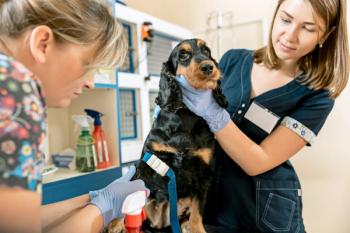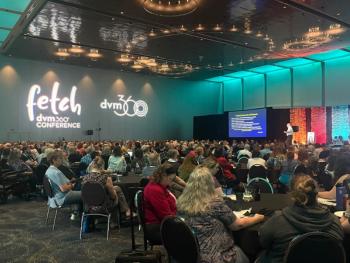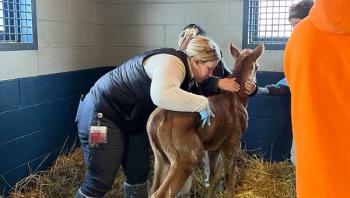
AVMA strives to build media powerhouse
Schaumburg, ILL. — The American Veterinary Medical Association (AVMA) is executing a plan to boost the profession's media presence, throwing its weight behind what officials describe as a "public image juggernaut."
SCHAUMBURG, ILL. — The American Veterinary Medical Association (AVMA) is executing a plan to boost the profession's media presence, throwing its weight behind what officials describe as a "public image juggernaut."
Mapped out by the AVMA Task Force on Communications, the strategy calls for $280,000 in new media-related positions, budget increases of $295,000 and a $165,000 research initiative to gauge public attitudes regarding veterinary medicine.
These efforts and others show AVMA eager to emerge as the nation's unmatched authority on animal and disease topics. Recognizing its lacking media presence, the association moves to stop wasting the profession's "enviable" image while groups such as the Humane Society of the United States (HSUS) address issues relevant to DVMs.
Key Findings
It's a strategy to strengthen AVMA on media relations and crisis management, tackling topics ranging from the economic status of animals to activist pressures on agricultural practices. Five years ago, AVMA communications tapped three employees. Today, 17 staff positions frame an entire division devoted to reaching media, the public and association members. When it comes to launching AVMA spin, Washington PR veteran J.B. Hancock is driving the machine as head of the association's Communications Division.
Wielding a high-touch cell phone and a no-nonsense attitude toward media relations, Hancock says the influx of funding and focus will provide the division with "the empowerment and staff resources to meet if not exceed member expectations."
"As a result AVMA communications will be more proactive, timely and influential," she says. "Our goal is to ensure that our members, the veterinary profession and the association receive recognition for the important role they play in animal and human health, safety and security."
Unwanted anonymity
That charge, in part, was born when former AVMA presidents Dr. Jack Walther and Dr. Bonnie Beaver met with Washington Post editors, and it became "painfully clear" the news agency had never heard of the association. Now communications task force chair, Walther's armed with a list of directives, each calling for unparalleled media outreach. In July, Executive Board members approved nine of the task force's 10 image-enhancing suggestions ranging from developing a policy to achieve association transparency to creating a crisis communications plan (see Table 1).
Table 1. Proposals designed to stimulate communications
"We spend several million dollars a year talking to ourselves in our own journal; we spend just a quarter of a million talking to the public," Walther says. "These recommendations will change the paradigm as to how communications at AVMA will work."
The model starts with the $295,000 budget increase for the Communications Division, granted as a lump sum to spend as needed. The request for discretionary spending "really raised some eyebrows," Walther says.
"This was revolutionary for the Executive Board, and it was a hard sell," he says. "But they realized that there's no way to predict communications challenges. They saw the need, and they really stuck their necks out."
Ultimate goals
That money gives AVMA the ability to put a face on the association during an information age when normal news cycles no longer exist, task force member Charlie Powell says.
In charge of public information for the Washington Veterinary Medical Association and Washington State University's veterinary college, Powell has managed media reports ranging from activist raids to the 2003 mad cow case discovered in the state. The media, he says, is "a hungry beast that needs to be fed." By failing to participate in that business relationship, the AVMA, in many cases, has fallen off the radar, he adds.
"When I see an animal story in the papers and on television, I want to see AVMA there," Powell says. "Does that mean we jump into every activist controversy? No. But for every activist-related media event there are 50 news stories more valuable to the profession that basically go unheeded. It's the equivalent to leaving money on the table."
Change underway
Nowadays, missed opportunities are less frequent. During the AVMA's annual convention in Minneapolis in July, press releases on House of Delegates activities flew out of a centralized communications hub manned by a handful of deadline-oriented media officers. When news organizations turned up to cover an activist painted as a pig and housed in a cage, the communications department acted fast, granting interviews with AVMA officials to tone down the emotion and plug the science surrounding sow gestation crates.
It's no longer unusual for data produced by the association to appear on the pages of USA Today, Boston Globe or The Wall Street Journal. National Public Radio covers press conferences put on by AVMA. And reporter requests of the association are expedited in high-priority fashion.
As a next step, Powell proposes support for a veterinary equivalent to the U.S. surgeon general to consult on animal and human health. He also wants veterinary authorities serving as regular medical consultants to large news organizations.
"Why when we're talking about famine in Africa is veterinary medicine not commenting on that?" he asks. "Veterinarians have the credibility, and that can bring incredible power and influence. With that kind of gas in the tank, it's fairly easy for this profession to transition to a higher media profile. People need to hear how veterinary medicine affects the entire world."
Newsletter
From exam room tips to practice management insights, get trusted veterinary news delivered straight to your inbox—subscribe to dvm360.





